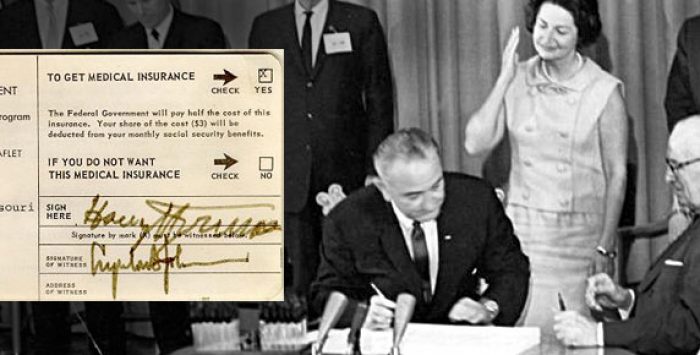President Truman called for creation of a national health insurance fund
Discussion about a national health insurance system for Americans goes back to the days of President Teddy Roosevelt, whose platform included health insurance when he ran for president in 1912. But the idea for a national health plan didn’t gain steam until it was pushed by U.S. President Harry S Truman.
On November 19, 1945, seven months into his presidency, Truman sent a message to Congress, calling for the creation of a national health insurance fund, open to all Americans. The plan Truman envisioned would provide health coverage to individuals, paying for such typical expenses as doctor visits, hospital visits, laboratory services, dental care and nursing services.
Although Truman fought to get a bill passed during his term, he was unsuccessful and it was another 20 years before some form of national health insurance – Medicare for Americans 65 and older, rather than earlier proposals to cover qualifying Americans of all ages – would become a reality.
President John F. Kennedy made his own unsuccessful push for a national health care program for seniors after a national study showed that 56% of Americans over the age of 65 were not covered by health insurance.
President Lyndon B. Johnson signed Medicare into law
But it wasn’t until after 1966 – after legislation was signed by President Lyndon B Johnson in 1965 – that Americans started receiving Medicare health coverage when Medicare’s hospital and medical insurance benefits first took effect. Harry Truman and his wife, Bess, were the first two Medicare beneficiaries.
As of 2025, nearly 69 million Americans had coverage through Medicare
By June 2025, nearly 69 million people — about 20% of the U.S. population — were receiving health coverage through Medicare.
Medicare spending reached nearly $1,030 billion in 2023, which was 21% of total national health spending.
A brief look at Medicare milestones
The ’60s
- On July 30, 1965 President Lyndon B. Johnson made Medicare law by signing H.R. 6675 in Independence, Missouri. Former President Truman was issued the very first Medicare card during the ceremony. In 1965, the budget for Medicare was around $10 billion.
- In 1966, Medicare’s coverage took effect, as Americans age 65 and older were enrolled in Part A and millions of other seniors signed up for Part B. Nineteen million individuals signed up for Medicare during its first year.
The ’70s
- In 1972, President Richard M. Nixon signed into law the first major change to Medicare. The legislation expanded coverage to include individuals under the age of 65 with long-term disabilities and individuals with end-stage renal disease (ERSD). People with disabilities have to wait 24 months for Medicare coverage, but Americans with ESRD can get coverage as early as three months after they begin regular hospital dialysis treatments – or immediately if they go through a home-dialysis training program and begin doing in-home dialysis. This has served as a lifeline for Americans with kidney failure – a devastating and extremely expensive disease.
The ’80s
- When Congress passed the Omnibus Reconciliation Act of 1980, it expanded home health services. The bill also brought Medigap – or Medicare supplement insurance – under federal oversight.
- In 1982, hospice services for the terminally ill were added to a growing list of Medicare benefits.
- In 1988, the Medicare Catastrophic Coverage Act became law, adding a true limit to the Medicare’s total out-of-pocket expenses for Part A and Part B, along with a limited prescription drug benefit. However, much of the Catastrophic Care law was repealed the following year, after opposition from senior groups over the program’s higher premiums. (To this day, there continues to be no cap on out-of-pocket costs for Medicare A and B.)
- One aspect of the 1988 law that continues to this day was the creation of the Qualified Medicare Beneficiary (QMB) Program (a type of Medicare Savings Program, or MSP), which requires states to “buy-in” to the Medicare system by using Medicaid funds to cover Medicare premiums and cost-sharing for impoverished Medicare beneficiaries. The majority of people with MSPs are enrolled in the QMB Program.
The ’90s
- New legislation required state Medicaid programs to cover premiums of the new Specified Low-Income Medicare Beneficiary (SLMB) eligibility group. The SLMB program is another type of MSP, with a higher income limit than the QMB program.
- Congress also passed the Qualified Individual (QI) program — another type of MSP, but with a higher income limit than the SLMB program. The QI program initially had to be reauthorized by Congress every few years, but it was made permanent in 2015.
- Other legislation gave those eligible for Medicare coverage more options on the private market through Medicare Part C – Medicare Advantage (MA). Originally known as Medicare HMOs or “Medicare+Choice” (among other names), the new private options ultimately offered add-on benefits such as prescription drug coverage for new enrollees. The Affordable Care Act requires more accountability from these plans, including tying the insurers’ reimbursements to the star rating system – a measure of several different ways the plans are required to provide quality care.
The ’00s
- Americans younger than age 65 with amyotrophic lateral sclerosis (ALS) are allowed to enroll in Medicare without a waiting period if approved for Social Security Disability Insurance (SSDI) income. (Most SSDI recipients have a 24-month waiting period for Medicare from when their disability cash benefits start.)
- President George W. Bush signed into law the Medicare Prescription Drug Improvement and Modernization Act of 2003, adding an optional prescription drug benefit known as Part D, which is provided only by private insurers. Medicare Part D plans became available as of 2006; Part D can be purchased as a stand-alone plan, but it can also be integrated with Medicare Advantage plans (most Medicare Advantage plans do include Part D drug coverage). As of 2025, nearly 56 million Medicare beneficiaries —more than 80% of the Medicare population — had Medicare Part D coverage (Medicare beneficiaries can also obtain prescription coverage from an employer or retiree program).
- Starting in 2007, a high-income surcharge (the income-related monthly adjustment amount, or IRMAA) began to be added to Part B premiums for enrollees with income above a certain threshold. This was part of the Medicare Prescription Drug Improvement and Modernization Act of 2003.
2010 and 2011
- The Patient Protection and Affordable Care Act of 2010 includes a long list of reform provisions intended to contain Medicare costs while increasing revenue, improving and streamlining its delivery systems, and even increasing services to the program.
- The income-related monthly adjustment amount (IRMAA) began to be added to Part D premiums for beneficiaries with high incomes (previously, it only applied to Part B premiums).
2015 through 2022
- In early 2015, after years of trying to accomplish reforms, Congress passed the Medicare and CHIP Reauthorization Act (MACRA), repealing a 1990s formula that required an annual “doc fix” from Congress to avoid major cuts to doctor’s payments under Medicare Part B. MACRA served as a catalyst through 2016 and beyond for CMS to push changes to how Medicare pays doctors for care – moving to paying for more value and quality over just how many services doctors provide Medicare beneficiaries.
- As noted above, MACRA also permanently authorized the QI program for certain low-income members’ Part B premium payments (among other extensions of Medicaid and CHIP – related programs).
- MACRA also added a 5th income bracket for IRMAA, starting in 2019. Prior to that, the highest bracket was for individuals with income above $160,000. But the 5th bracket began to apply in 2019 for people with an income of at least $500,000 and has remained at that level ever since (the other bracket thresholds have been indexed for inflation since 2020, but the 5th level has remained at $500,000).
- The donut hole “closed” as a result of the ACA. It was fully eliminated as of 2020 (it closed one year early – in 2019 – for brand-name drugs, but generic drugs still cost more while enrollees were in the donut hole in 2019). For the next several years, enrollees with standard Part D plans paid 25% of the cost of their drugs until they reached the catastrophic coverage limit (as opposed to paying the full cost of the drugs while in the donut hole, which had been the case before the ACA started to close the donut hole in 2010/2011).
- In 2020, the income thresholds for IRMAA surcharges began to be adjusted for inflation. (IRMAA surcharges are added to Part B and Part D premiums for high-income Medicare beneficiaries).
- The Inflation Reduction Act was signed into law in August 2022. This legislation includes significant improvements in drug coverage for Medicare beneficiaries.
2023 through 2029
- In 2023, under the Inflation Reduction Act (IRA), certain recommended vaccines became free under Medicare Part D (vaccines covered by Part B are already free). And all Part D plans most offer all of their covered insulin products with cost-sharing of no more than $35/month.
- In 2024, under the IRA, the Part D full Low-Income Subsidy (Extra Help) became available to more people, and there was no longer any out-of-pocket spending once Part D beneficiaries reached the catastrophic coverage phase. And from 2024 through 2030, growth of the Part D national base beneficiary premium is capped at 6% per year.
- In 2025, there was an out-of-pocket cap of $2,000 for Part D coverage, including stand-alone Part D plans and Part D coverage that’s integrated with Medicare Advantage. The cap will be indexed in future years; for 2026, it’s $2,100.
- Starting in 2026, lower prices take effect for some high-cost drugs, due to negotiations between Medicare and the drug manufacturers. This will be phased in from 2026 through 2029, with additional drugs added each year.
For more information, view the Kaiser Family Foundation’s comprehensive Medicare timeline.




